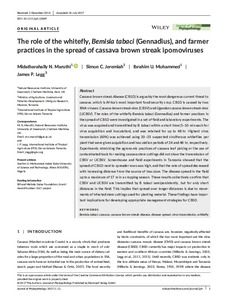| dc.contributor.author | Maruthi, M.N. |
| dc.contributor.author | Jeremiah, S.C. |
| dc.contributor.author | Mohammed, I.U. |
| dc.contributor.author | Legg, J.P. |
| dc.date.accessioned | 2019-12-04T11:09:07Z |
| dc.date.available | 2019-12-04T11:09:07Z |
| dc.date.issued | 2017 |
| dc.identifier.citation | Maruthi, M.N., Jeremiah, S.C., Mohammed, I.U. & Legg, J.P. (2017). The role of the whitefly, Bemisia tabaci (Gennadius), and farmer practices in the spread of cassava brown streak ipomoviruses. Journal of Phytopathology, 1-11. |
| dc.identifier.issn | 0931-1785 |
| dc.identifier.uri | https://hdl.handle.net/20.500.12478/1981 |
| dc.description | Article purchased; Published online: 22 August 2017 |
| dc.description.abstract | Cassava brown streak disease (CBSD) is arguably the most dangerous current threat to cassava, which is Africa's most important food security crop. CBSD is caused by two RNA viruses: Cassava brown streak virus (CBSV) and Ugandan cassava brown streak virus (UCBSV). The roles of the whitefly Bemisia tabaci (Gennadius) and farmer practices in the spread of CBSD were investigated in a set of field and laboratory experiments. The virus was acquired and transmitted by B. tabaci within a short time (5–10 min each for virus acquisition and inoculation), and was retained for up to 48 hr. Highest virus transmission (60%) was achieved using 20–25 suspected viruliferous whiteflies per plant that were given acquisition and inoculation periods of 24 and 48 hr, respectively. Experiments mimicking the agronomic practices of cassava leaf picking or the use of contaminated tools for making cassava stem cuttings did not show the transmission of CBSV or UCBSV. Screenhouse and field experiments in Tanzania showed that the spread of CBSD next to spreader rows was high, and that the rate of spread decreased with increasing distance from the source of inoculum. The disease spread in the field up to a maximum of 17 m in a cropping season. These results collectively confirm that CBSV and UCBSV are transmitted by B. tabaci semipersistently, but for only short distances in the field. This implies that spread over longer distances is due to movements of infected stem cuttings used for planting material. These findings have important implications for developing appropriate management strategies for CBSD. |
| dc.description.sponsorship | Bill & Melinda Gates Foundation |
| dc.format.extent | 1-11 |
| dc.language.iso | en |
| dc.subject | Cassava |
| dc.subject | Diseases |
| dc.subject | Bemisia Tabaci |
| dc.subject | Virus Diseases |
| dc.subject | Cassava Brown Streak Disease |
| dc.subject | Disease Spread |
| dc.subject | Virus Transmission |
| dc.subject | Whitefly |
| dc.title | The role of the whitefly, Bemisia tabaci (Gennadius), and farmer practices in the spread of cassava brown streak ipomoviruses |
| dc.type | Journal Article |
| dc.description.version | Peer Review |
| cg.contributor.crp | Climate Change, Agriculture and Food Security |
| cg.contributor.crp | Genebanks |
| cg.contributor.crp | Roots, Tubers and Bananas |
| cg.contributor.affiliation | University of Greenwich |
| cg.contributor.affiliation | Ministry of Agriculture, Livestock and Fisheries Development, Tanzania |
| cg.contributor.affiliation | International Institute of Tropical Agriculture |
| cg.coverage.region | Africa |
| cg.coverage.region | East Africa |
| cg.coverage.country | Tanzania |
| cg.isijournal | ISI Journal |
| cg.authorship.types | CGIAR and developing country institute |
| cg.iitasubject | Cassava |
| cg.iitasubject | Disease Control |
| cg.iitasubject | Plant Diseases |
| cg.journal | Journal of Phytopathology |
| cg.howpublished | Formally Published |
| cg.accessibilitystatus | Open Access |
| local.dspaceid | 85537 |
| cg.targetaudience | Scientists |
| cg.identifier.doi | http://dx.doi.org/10.1111/jph.12609 |

